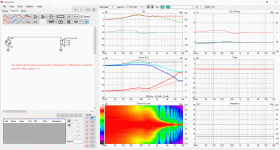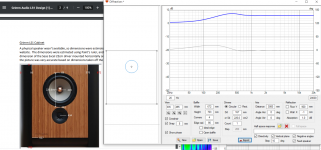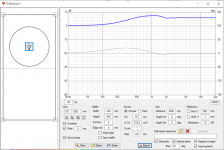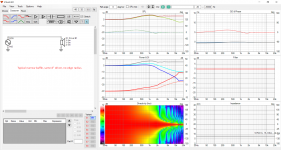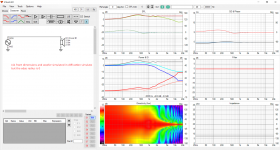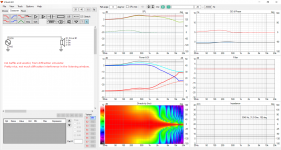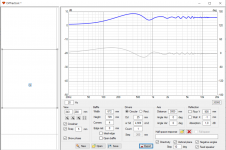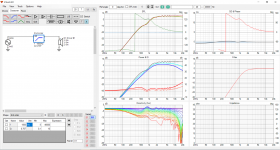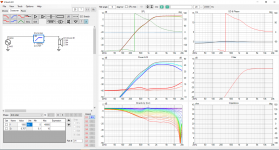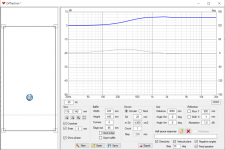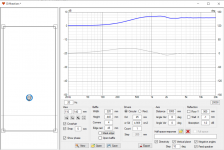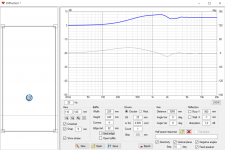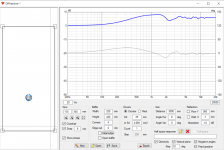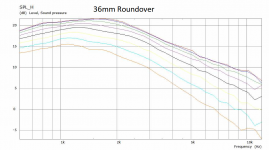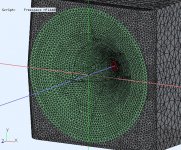I've got to eat some of my words instead of popcorn 😀
Attached some vituixCAD diffraction sim photos which say my words about roundovers being just about minimizing the flat front misleading since the roundovers help with the directivity lower in frequency than anticipated as well. Any roundover seem to help altough larger roundovers and big enclosures are a lot harder to manufacture than simple small square boxes.
The directivity changes with large baffle which should be advantageous. Actually the grim baffle seems to show almost constant directivity between about 300-1kHz and constant directivity is the thing.
Tree baffles simmed, the grimm ls1 dimensions are found from the PDF I posted earlier. One sim is with roundovers, one without and third one is kind of minimal square front for 8" twoway without any roundovers. Mind that the roundover is on all sides in the sim where as LS1 has roundovers on the sides only so there is some error. Also I'm not sure how the sim handles depth so this is kind of indicative stuff, not too scientific. Driver is ideal driver so flat frequency response all the way.
First attachment is a gif rolling around the three sims. Then the diffraction tool settings and the images used in the gif.
Note that the narrow baffle without any radius has almost as smooth diffraction interference as the wide baffle with huge roundovers. Main difference is that the wide baffle controls directivity to low frequency.
Attached some vituixCAD diffraction sim photos which say my words about roundovers being just about minimizing the flat front misleading since the roundovers help with the directivity lower in frequency than anticipated as well. Any roundover seem to help altough larger roundovers and big enclosures are a lot harder to manufacture than simple small square boxes.
The directivity changes with large baffle which should be advantageous. Actually the grim baffle seems to show almost constant directivity between about 300-1kHz and constant directivity is the thing.
Tree baffles simmed, the grimm ls1 dimensions are found from the PDF I posted earlier. One sim is with roundovers, one without and third one is kind of minimal square front for 8" twoway without any roundovers. Mind that the roundover is on all sides in the sim where as LS1 has roundovers on the sides only so there is some error. Also I'm not sure how the sim handles depth so this is kind of indicative stuff, not too scientific. Driver is ideal driver so flat frequency response all the way.
First attachment is a gif rolling around the three sims. Then the diffraction tool settings and the images used in the gif.
Note that the narrow baffle without any radius has almost as smooth diffraction interference as the wide baffle with huge roundovers. Main difference is that the wide baffle controls directivity to low frequency.
Attachments
Last edited:
The LS1 have an interessant feature: the bsc have it's -3db frequency located around 220/250hz.
A 4" radius roundover see it's effect loosing control under 1khz.
Bsc and edge diffraction are the same phenomenon but at different frequency.
By this choice of baffle width/roundover radius both artefacts are treated continously: edge diffraction control take effect where bsc compensation stop ( almost) and vice versa ( bsc span 4 octave ( 2 both side 60hz/1khz) with center freq 250hz and edge diffraction control by roundover start at 1khz).
I don't know if it matters but i don't trust in coincidence too much...
A 4" radius roundover see it's effect loosing control under 1khz.
Bsc and edge diffraction are the same phenomenon but at different frequency.
By this choice of baffle width/roundover radius both artefacts are treated continously: edge diffraction control take effect where bsc compensation stop ( almost) and vice versa ( bsc span 4 octave ( 2 both side 60hz/1khz) with center freq 250hz and edge diffraction control by roundover start at 1khz).
I don't know if it matters but i don't trust in coincidence too much...
Last edited:
Yeah here is the tweeter, edge radius 0 and the LS1 95mm radius. Diffraction interference is still seen below about 1kHz on the polar graph. Added low pass filter to mimic the real one a bit closer (instead of playing all the way down to 20Hz).
Check out the non edge radius (second attachment) polar graph, pretty much diffraction related interference all the way from the baffle width to the driver diameter! This led to my rule of thumb, when driver diameter and baffle size get closer to each other, eg. baffle is the same size as the driver the ripple (bandwidth) goes to minimum. In this particular case the baffle is wider than the bandwidth of the tweeter. Hence, with roundovers tweeter has pretty much flat response with wide baffle as well.
Check out the non edge radius (second attachment) polar graph, pretty much diffraction related interference all the way from the baffle width to the driver diameter! This led to my rule of thumb, when driver diameter and baffle size get closer to each other, eg. baffle is the same size as the driver the ripple (bandwidth) goes to minimum. In this particular case the baffle is wider than the bandwidth of the tweeter. Hence, with roundovers tweeter has pretty much flat response with wide baffle as well.
Attachments
Last edited:
And one more, this is the "narrow baffle" from few posts before but now with a 1" tweeter instead of 8" woofer. If the baffle is as wide as the woofer, the direct radiating tweeter on same baffle gets pretty nasty diffraction interference. Attachments have roundovers 0, 22mm, 45mm and 95mm. This supported my minimize flat baffle thinking and the trapedzoid baffle fluid mentioned earlier today. Every driver seem to benefit from minimum baffle around it, or big enough roundovers. 10cm (4") radius roundovers seem to be good to about 1kHz but have some effect below it.
Anyway, the important point in all this is that the acoustic design of enclosure is part of well designed loudspeaker and the LS1 seems to be one. Square baffle having various size drivers on it without roundovers completely ignores this aspect.
Anyway, the important point in all this is that the acoustic design of enclosure is part of well designed loudspeaker and the LS1 seems to be one. Square baffle having various size drivers on it without roundovers completely ignores this aspect.
Attachments
This article from Alexander Heissmann is a good overview with measurements and images.
Basic article | Baffle geometry
Basic article | Baffle geometry
Here is an example of the difference between a variable radius roundover and a plain 36mm one. Hard to know if one is better rather than just different.


Attachments
Bsc and edge diffraction are the same phenomenon but at different frequency...
Not quite. Baffle step effect presents gain in frequencies with wavelength shorter than baffle dimensions.
Edge diffraction presents aditional source of sound reflected of sharp edges that, depending on conctruction of the cabinet, makes destructive interference with direct sound from transducer causing dips and peaks in measured response.
Hi Zvu,
From your description we agree on what are both effects (bsc and edge diffraction) so we diverge on the 'source' of both phenomenon.
I say both are diffraction ( they share same physic principle at work), the differences between them being in three parameters: wavelength at which the effect occurs, size of obstacle and the shape of the later.
If we look at an enclosure being a sphere and focus on baffle step loss only the profile will be smooth transfer function ( there is low ripple).
As soon as one introduce abrupt angle ripples appears.
As we agree you'll tell me it is relative to baffle edge diffraction and i'll agree too but i'll add that the first 'bump'/peak will change with different form factor and this is not only due to edge diffraction.
From my understanding this is related to destructive/ constructive interference but it happen way lower in freq than where a typical roundover ( let's say 10cm /4" being the max of typical) have control.
It is also why we usually assume the rule of thumb of 115 (or 116) / baffle width in meter is ok to determine the bsc center freq: it assumes a sphere but in practice it is close to what we face with different shape of enclosure. In practice it rarely fit perfectly the profile but it 'works' as the general profile is still the 'trend'. So when using a shelf to compensate we focus on minimum phase and 'forget' the ripples which are not.
You'll see example i talked about there an a better explanation than mine here:
True Audio TechTopics: Diffraction Loss
And here it tends to point to the same explanation for me ( at least this is how i understand the last paragraph):
Diffraction from baffle edges
And this discussion with Patrick Bateman could help to see why i think as is too:
https://www.diyaudio.com/forums/mul...es-lead-narrower-beamwidth-5.html#post6556549
I'm not sure if it is clear enough but can't see how to express it an other way. Maybe i'm wrong in my understanding? If that is the case please feel free to bring where i'm wrong and why.
Zvu could you describe why you see they are unrelated/ different phenomenon please?
From your description we agree on what are both effects (bsc and edge diffraction) so we diverge on the 'source' of both phenomenon.
I say both are diffraction ( they share same physic principle at work), the differences between them being in three parameters: wavelength at which the effect occurs, size of obstacle and the shape of the later.
If we look at an enclosure being a sphere and focus on baffle step loss only the profile will be smooth transfer function ( there is low ripple).
As soon as one introduce abrupt angle ripples appears.
As we agree you'll tell me it is relative to baffle edge diffraction and i'll agree too but i'll add that the first 'bump'/peak will change with different form factor and this is not only due to edge diffraction.
From my understanding this is related to destructive/ constructive interference but it happen way lower in freq than where a typical roundover ( let's say 10cm /4" being the max of typical) have control.
It is also why we usually assume the rule of thumb of 115 (or 116) / baffle width in meter is ok to determine the bsc center freq: it assumes a sphere but in practice it is close to what we face with different shape of enclosure. In practice it rarely fit perfectly the profile but it 'works' as the general profile is still the 'trend'. So when using a shelf to compensate we focus on minimum phase and 'forget' the ripples which are not.
You'll see example i talked about there an a better explanation than mine here:
True Audio TechTopics: Diffraction Loss
And here it tends to point to the same explanation for me ( at least this is how i understand the last paragraph):
Diffraction from baffle edges
And this discussion with Patrick Bateman could help to see why i think as is too:
https://www.diyaudio.com/forums/mul...es-lead-narrower-beamwidth-5.html#post6556549
I'm not sure if it is clear enough but can't see how to express it an other way. Maybe i'm wrong in my understanding? If that is the case please feel free to bring where i'm wrong and why.
Zvu could you describe why you see they are unrelated/ different phenomenon please?
Last edited:
Because you don't have destructive interference with baffle step effect but with edge diffraction you do.
I'll post some measurements this evening, when i come home, of 7" midwoofer in a square cabinet with quasi-anechoic response good down to 100Hz or a bit lower.
I'll post some measurements this evening, when i come home, of 7" midwoofer in a square cabinet with quasi-anechoic response good down to 100Hz or a bit lower.
Ok please do.
But the destructive interference aren't just a different effect at a different frequency from the same principle?
Same as the difference between audio and light in this video? :
Wave Diffraction - YouTube
I've read interesting exchange about this between DbMandrake and Earl Geddes but of course can't find the thread... it was interesting as it put some other points discussed previously into perspective too ( Tmuikku approach of small baffle... but with 15" drivers which shift the overall view of small width baffle and effects cause with a large driver, small baffle will be large anyway relative to the standards of the moment).
But the destructive interference aren't just a different effect at a different frequency from the same principle?
Same as the difference between audio and light in this video? :
Wave Diffraction - YouTube
I've read interesting exchange about this between DbMandrake and Earl Geddes but of course can't find the thread... it was interesting as it put some other points discussed previously into perspective too ( Tmuikku approach of small baffle... but with 15" drivers which shift the overall view of small width baffle and effects cause with a large driver, small baffle will be large anyway relative to the standards of the moment).
Last edited:
By small baffle i mean it is relative to the size of the driver. Cant be smaller than the driver, only larger.
Diffraction means wave bends around corner. Doing so it emits backscatter or howd ya call it. Baffle step happens when the enclosure begins to be acoustically small when wavelenghts get longer and less and less diffraction happens until long enough wavelenghts just don't "see" the enclosure anymore.
all sound that travels along the baffle edge diffracts if it is short wavelenghts compared to the enclosure size. But, as the transducer starts to beam, or waveguide guides the sound, it doesnt travel along the baffle anymore and no edge diffraction happens. This depends on the transducer size.
Diffraction means wave bends around corner. Doing so it emits backscatter or howd ya call it. Baffle step happens when the enclosure begins to be acoustically small when wavelenghts get longer and less and less diffraction happens until long enough wavelenghts just don't "see" the enclosure anymore.
all sound that travels along the baffle edge diffracts if it is short wavelenghts compared to the enclosure size. But, as the transducer starts to beam, or waveguide guides the sound, it doesnt travel along the baffle anymore and no edge diffraction happens. This depends on the transducer size.
Last edited:
^ i think we agree. 🙂
Until recently i was like Zvu considering bsc and baffle edge diffraction as differents because they needed to be adressed differently. In fact Norman Bates threads and other exchange with members here made me think differently now. Same thing, differents effects so are the 'cure'. But basically this is the same thing at work to me.
My thoughts about wide or narrow baffle is relative. Earl Geddes explained that he used the smallest baffle size possible for Summa including the 'big' roundover ( 10cm/4" radius) iirc. This lead to a big face relative to the norm of the moment.
Which shift the bsc behavior to something close to LS1 you simmed: increasing control of directivity lower in freq ( almost to schroeder freq of small/medium room).
And is happy as it complement the OS waveguide. Iirc the xover is around 900hz so the waveguide should take care of most edge diffraction yet Earl included roundover which control down to this freq.
Maybe it is just another step to optimise even more regarding diffraction and overall philosphy behind Summa? Or he felt it was needed to even more smooth out the transition i don't know?
Whatever it was included and scaled down to the other models he produced.
He admited too that he really liked the result with coax used nude, without baffle but didn't follow this path as it was difficult approach from business perspective.
Either a 'large' baffle with edge diffraction control, either no at all brings good it seems. In between...? Why i think it should be looked at with reference to the philosophy/design goals beneath the choices made.
Until recently i was like Zvu considering bsc and baffle edge diffraction as differents because they needed to be adressed differently. In fact Norman Bates threads and other exchange with members here made me think differently now. Same thing, differents effects so are the 'cure'. But basically this is the same thing at work to me.
My thoughts about wide or narrow baffle is relative. Earl Geddes explained that he used the smallest baffle size possible for Summa including the 'big' roundover ( 10cm/4" radius) iirc. This lead to a big face relative to the norm of the moment.
Which shift the bsc behavior to something close to LS1 you simmed: increasing control of directivity lower in freq ( almost to schroeder freq of small/medium room).
And is happy as it complement the OS waveguide. Iirc the xover is around 900hz so the waveguide should take care of most edge diffraction yet Earl included roundover which control down to this freq.
Maybe it is just another step to optimise even more regarding diffraction and overall philosphy behind Summa? Or he felt it was needed to even more smooth out the transition i don't know?
Whatever it was included and scaled down to the other models he produced.
He admited too that he really liked the result with coax used nude, without baffle but didn't follow this path as it was difficult approach from business perspective.
Either a 'large' baffle with edge diffraction control, either no at all brings good it seems. In between...? Why i think it should be looked at with reference to the philosophy/design goals beneath the choices made.
Last edited:
I am the OP. May I say something about the last two pages?
HUH? lol
I was looking around and found something exciting looking.
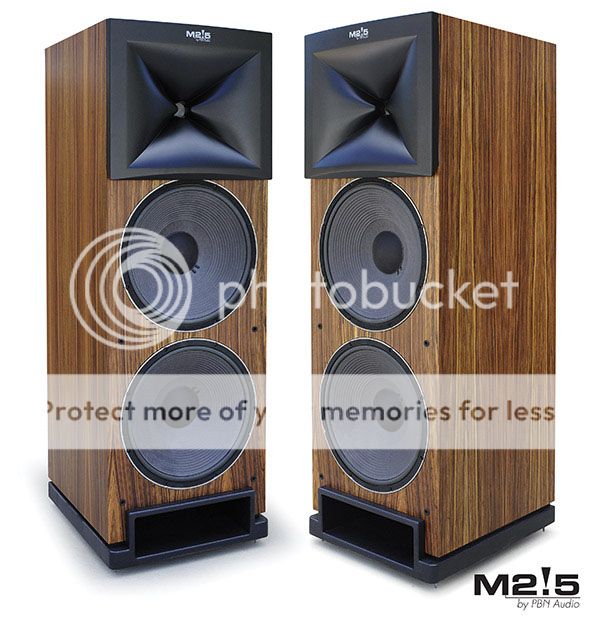
Then I saw who it was from, again ... lol
These look cool !
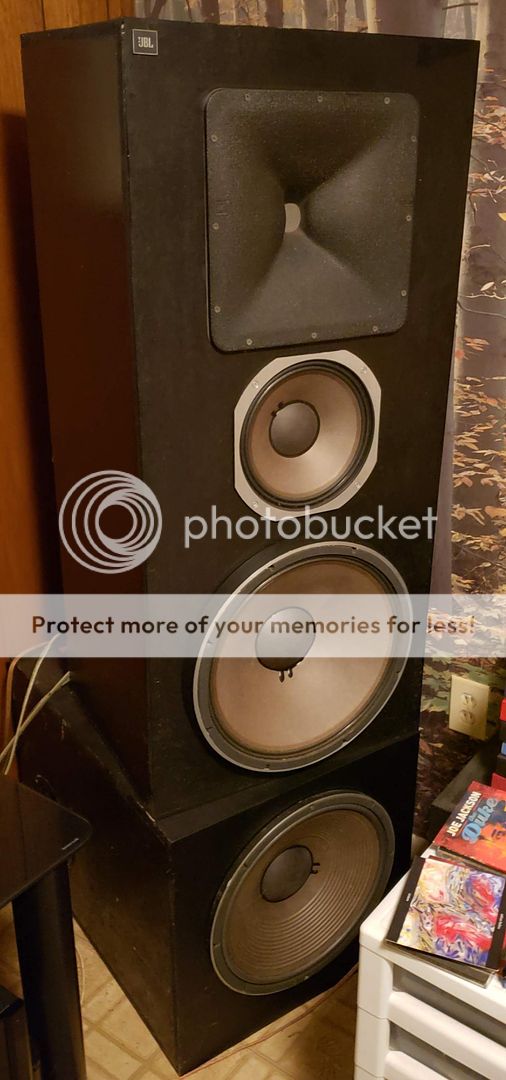
HUH? lol
I was looking around and found something exciting looking.

Then I saw who it was from, again ... lol
These look cool !

Waveguide brings the tweeter to the woofer size nicely. In the ATH thread waveguide sims and measurements show best performance yet. Cross it to a properly sized woofer without baffle /minimal baffle/roundovers and diffraction "problem" doesn't exists since the problematic bandwidth is on the waveguides responsibility and freestanding device with proper mouth rollback doesn't show practically any interference 🙂 anyway, many ways to skin the cat like LS1 showed. Many loudspeakers, commercial or diy, don't show any effort. I think addressing the issue one way or another is good thing to do if looking for best sound.
Last edited:
Sorry for OT Flaxxer 🙂
When you put it like that, i see what you mean but that's not how, at least i, comprehended what you wrote.
Baffle step effect exists on all, but edge diffraction just on certain freequencies. Once you do the roundover of the baffle with 5cm radius or more, you render it for all practical purposes irrelevant - unlike baffle step that is always relevant.
If it is the same thing, we would call it the same name but would differ just with frequency, as is the case with baffle step effect.
Measurements i promised. 0 and 45 degrees.
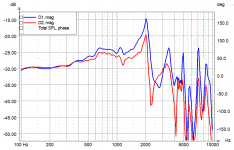
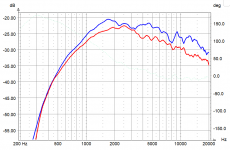
Anyhow, in the great scheme of things, what we think or call them is irrelevant as long we recognize the effects and know how to mitigate them 🙂
Ok please do.
But aren't the destructive interference just a different effect at a different frequency from the same principle?
When you put it like that, i see what you mean but that's not how, at least i, comprehended what you wrote.
Baffle step effect exists on all, but edge diffraction just on certain freequencies. Once you do the roundover of the baffle with 5cm radius or more, you render it for all practical purposes irrelevant - unlike baffle step that is always relevant.
If it is the same thing, we would call it the same name but would differ just with frequency, as is the case with baffle step effect.
Measurements i promised. 0 and 45 degrees.


Anyhow, in the great scheme of things, what we think or call them is irrelevant as long we recognize the effects and know how to mitigate them 🙂
Last edited:
Conventional edge diffraction does happen at all frequencies in the range. It may only be obvious at some frequencies on a response plot, but a response plot shows only some of what it does.
Prove that it happens at all frequencies. I'm dying to see the effect of edge diffraction at 300Hz.
Last edited:
I'll try if I can understand your point, maybe you'd give an example.
I said "in the range" suggesting above the baffle step. There is some contention as to what constitutes diffraction once you get into the driver's near-field.
I said "in the range" suggesting above the baffle step. There is some contention as to what constitutes diffraction once you get into the driver's near-field.
Prove that it happens at all frequencies. I'm dying to see the effect of edge diffraction at 300Hz.
Hi, graphs will look exactly the same as with shorter wavelenghts. Just use big enough baffle, the stuff scales with the physical dimensions. Try vituixCad diffraction sim, it takes only few minutes to find answers all questions you can ask 🙂
- Home
- Loudspeakers
- Multi-Way
- I'm building a $4000 speaker kit ... Which one?
